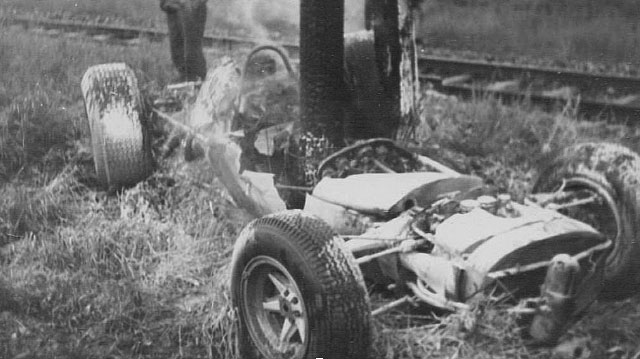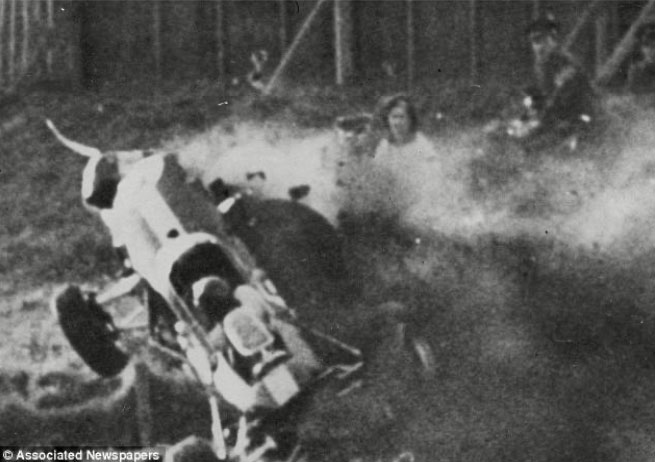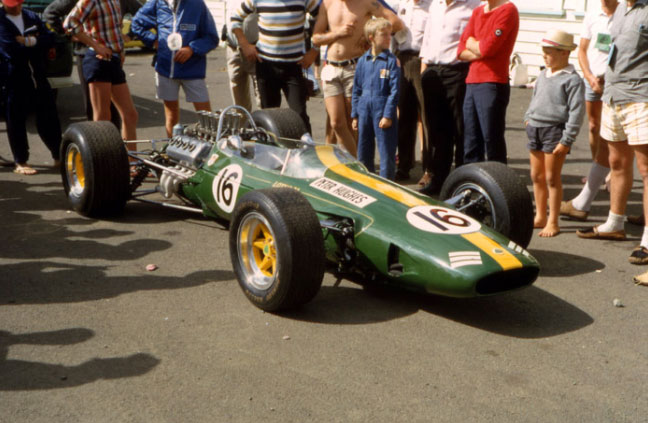This story begins back in ‘67 when I first saw Peter Yock’s Lotus 33 in the Baypark paddock. Except it wasn’t a Lotus 33, it was a 25. The history of this car can be found in Eoin Young’s book “Jim Clark and his Most Successful Lotus”. This ties the car back to the Lotus 25, serial number R4, that was Jimmy’s mount for his title wining run in 1963, and that served as the team spare for the following season. R4 was written off at Spa in 1965 when Richard Attwood wrapped it around a telegraph pole. A rainstorm caught him out:

“I was entering onto the Masta straight after Burnenville corner, the road slopes and there was a river running across. I hit that, the car snapped sideways and I careered down the road for about 400 yards with the brakes on. I was slowing but it seemed to be taking a l-o-n-g time. Eventually the car hit a telegraph pole and wrapped itself around it, just about where I was sitting, so that the monocoque collapsed around the pole. I probably hit it doing about 30 mph but I can’t remember the impact … I got out of there but I’ve got no idea how…”
The undamaged bits of R4 found their way onto another Lotus 25 tub. The question I now ask is – does that make it the same car or a different one? The resulting car re-emerged with a new serial number, R13, and a new designation as a Lotus 33. What can we tease out of this?
The Disappearing 25s
Writing off Lotus 25s was not a rare event. Trevor Taylor managed the trick three times. In R1, the prototype, he got caught in a high speed game of dodgems after the Gendemarie blocked access to the pits while cars were still finishing the ‘62 French Grand Prix, in R5 he had a suspension mounting break in practice for the ‘63 Belgian GP, and he got flicked into a high speed roll when R2 was sprayed with dust and stones by a hard charging Bandini at Enna, also in ‘63,.

It was said that Clark didn’t have accidents, Taylor had them for him. But that is not quite true. Jimmy wrote off two 33s in non championship races. R8 at Aintree in ‘64, when he was forced off line lapping a back marker, and R10 a year later (photo) when under great pressure from Gurney at Brands Hatch. (R8 was reskinned and repaired only for Hawkins to sink it in the harbour at Monaco in ‘65. Later it disappeared into the pool of cars used in the ‘66 MGM flick “Grand Prix.” R10 never raced again).
To round things out Mike Spence crashed R3 in practice for the ‘66 Mexican Grand Prix, after which the car disappeared. R6 and R9 were also in the car pool for the “Grand Prix” movie, and disappeared along with R8. It is really no wonder that Lotus 25s and 33s are now hard to find.
Even with these disappearances and write-offs R4 remains unique. Not because it was brought back to life but because it got a new identity at the same time. No-one wants to own up to the identity change, or more likely to the Lotus 33 designation that came with it, but the change itself makes perfect sense. R13 was clearly a new car. What doesn’t make sense is linking it to the ’62
title winning car R4 (see below). None of the basic assemblies of R4, in its ‘63 form, were used in R13. The chassis/tub was that of a 25B, the body was not reused, the engine was BRM rather than Climax, a Hewland gearbox replaced the original ZF unit, and the running gear and suspension was in the distinctly different 25B form for smaller diameter wheels and wider tyres.
A Test for Originality:
In the late ’70s, Doug Nye and Dennis Jenkinson put together a protocol on “in period” provenance for the British Vintage Sports Car Club. This was intended to be used to determine identity questions on member’s cars. A synopsis of it is set out below.
1. There are five basic assemblies to be taken into account. The chassis, body, engine, drive train and running gear. All five present and correct is “original”. Four to five is “pretty good”, two is beginning to look “iffy” and none is a “lookalike”.
2. The deciding structure conferring period identity is the chassis.
3. As the original chassis and body are the most likely elements to survive the ravages of time, then anything with chassis and body intact, but with replacement mechanical parts, has an “excellent” claim for being “in period”.
4. A chassis and nothing else has a better claim to a specific identity than a set of body panels and a pile of mechanical bits. The bits can only be viewed as parts from the nominated car from some time in the past.
5. A car with original mechanical bits only and replacement chassis and body cannot be “in period”. It may have a traceable provenance to car X, but cannot be that same actual car.
6. Replacement chassis for the same set of mechanical bits each have their own unique history, even they carry the same serial number.
7. If there were multiple factory chassis with the same serial number then the chassis to which the number was first applied takes preference in claiming the identity.

Applying this test to R13 yields two separate cars, on two different chassis, with two separate histories. The history of R4 ended on that power pole at Spa in ‘65. The history of R13 began when Ireland drove it onto the grid for the ‘65 Italian Grand Prix. There is tacit recognition in the in period records that the rebuild was indeed a car into itself. At the time of the rebuild R13 was the next available number in the Lotus 25/33 production sequence, and never turned up anywhere else. (R14 did, a few months later, on the last 33 ever made). So R13 was a factory recognised number, properly applied to the chassis onto which the surviving bits of bits of R4 were attached. The photo shows it with a Daimler V8 as ran by Peter Hughes in New Zealand in 1968.
Young records that the tub for R13, in a very sorry state, was eventually recovered from New Zealand and the car recreated in the original image of R4. The repaired tub used the original outer skins, front bulkhead and instrument panel. While it appears to have been re-identified as R4, no part of the original R4 remains. The rebuild is not a reconstruction of R4, rather it is a beautiful replication of it.Footnote: Lotus 33s are tidied up 25s, and shared the same numbering sequence. Advancing tyre technology in the ‘60s lead to suspension and tub pick up modifications to suit the new tyres. The 33s had these from the start. The older 25s were modified to suit. Depending on the degree of modification you may find the older cars referred to as 25B, 25C or 25D.
